From 1835 to
the present day
With the sale of Church-owned properties organized by the revolutionary government in 1791, Charlemagne's vines left the hands of the monks of Saint-Andoche in Saulieu and were bought at auctions by François Ray and quickly resold to Simon Very.
Marie-Eugénie, Simon Very's daughter, married Charles Bonneau du Martray, who was a descendant of Nicolas Rolin, the founder of the Hospices de Beaune. Her dowry included approximately 60 acres of vineyards in Pernand-Vergelesses, Aloxe-Corton, and Volnay.
In the 19th century, the Bonneau du Martray family owned a few acres of vines whose heart and jewel were the entire Charlemagne climate in the commune of Pernand-Vergelesses.
Their son, Marie-Eugène Bonneau du Martray is an essential link in the history of the Domaine. He allowed the Domaine to go through the ups and downs of history without suffering: during the wars of 1870, 1914-18, phylloxera, and beyond. The action of this brilliant engineer during these dark hours preserved the integrity of the estate.
René Bonneau du Martray, son of Eugène, also experienced his share of historical events. Born in 1886, he suffered the horrors of the two world wars; he suffered physically from them for the rest of his life. Despite the difficulties he endured, René took his responsibility at the head of the family vineyard very seriously.
René Bonneau du Martray did not have children, so he bequeathed the property to his niece Alice Colonna de Giovellina, who married Jean le Bault de la Morinière.
The arrival of Jean le Bault de la Morinière at the Domaine in 1969 marked the beginning of international recognition for the Bonneau du Martray wines. Sales were organised in France as well as in foreign countries; the Domaine's two great wines were present on the most prestigious tables. Devoted entirely to his family vineyard, Jean worked hard to continue the work of his predecessors, including constructing walls and ditches to fight erosion in the vineyard. He introduced temperature control in the cellar to guarantee fermentations under the best conditions, an innovative approach at the time. From the vineyard - with a qualitative renewal of the vines - to the cellar, Jean le Bault de la Morinière converted Domaine Bonneau du Martray into a reference among the producers of great Burgundy wines.
His son, Jean-Charles le Bault de la Morinière, joined the Domaine in 1994.
Since 1997, Jean-Charles gradually oriented the Domaine towards organic farming, and its first biodynamic trials were launched in the fall of 2004. The full conversion to biodynamic was completed in 2011. It is Jean-Charles' firm belief that "we are accountable for a better understanding of the complexity of the environment in order to preserve its integrity, vitality and diversity". Jean-Charles' focus on quality in the vineyard and cellar had an immediate impact, reinforcing Bonneau du Martray's status with the most discerning wine connoisseur around the globe.
Five generations have built upon the others' successes, each participating through the ages to raise the Domaine to the highest rank, worthy of Emperor Charlemagne.


